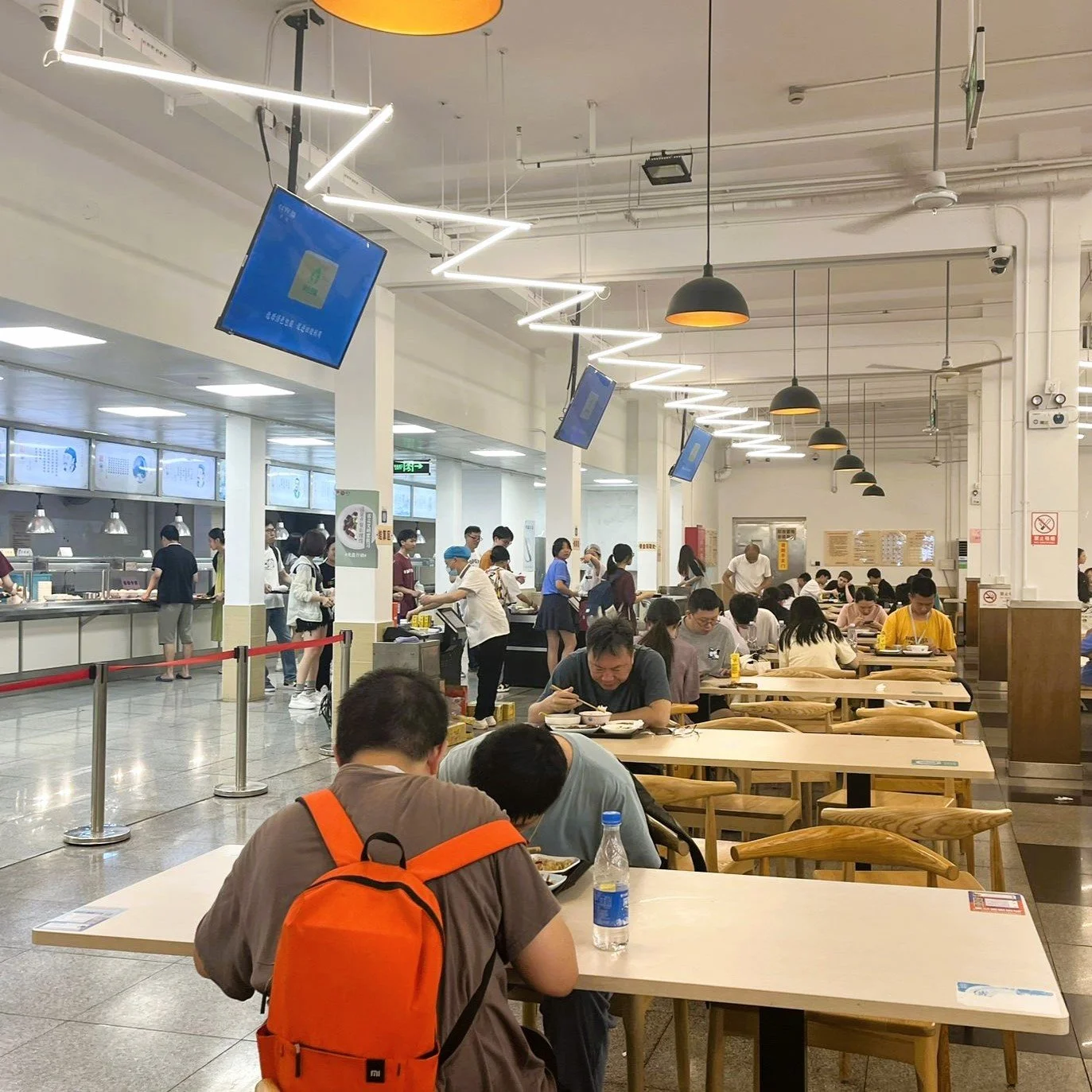On the Chinese campus canteen
The Chinese campus canteen is an overlooked institution, providing sustenance and representing the deep-rooted tradition of communal eating.
Image credits: Emily Kwok
When I studied in Mainland China during my gap year, I ate at the 食堂 (shitang - canteen) almost every day. Sometimes, for three meals a day: glutinous steamed corn and fried dough sticks for breakfast, duck blood soup noodles for lunch, and tomato egg stir fry with rice for dinner. Hundreds of us would congregate in the canteen at once, efficiently hurried along the production line within minutes.
Eating at the canteen quickly became an important ritual for me. Even when I lived at home, the daily rhythm of eating at the dining table together no longer required such strict adherence as it did throughout my childhood. Many of us prefer to eat before our laptops, standing in the kitchen, or on the couch in the loving company of Troy and Abed from Community. But without family to gather at the dining table with, the canteen was sacred, existing purely as a space to enjoy food with others.
The Chinese campus canteen is a humble place, but in many ways, it feels like a luxury. In Sydney, to enjoy three meals a day for under 10 dollars is an impossibility. It’s as far-fetched as renting a studio in the Inner West as a casual worker. Of course, the two cities couldn’t be more different. In Nanjing, most students live on campus. For international students, this could entail a spacious studio, accompanied by a kitchen and even a balcony. Domestic students, on the other hand, are relegated to a six-person room, or if you were lucky, only four of you would compete for the best bunk. Regardless, most students relied on the canteen for their livelihoods, which was still significantly cheaper than eating out at restaurants or even cooking for yourself.
In 1950s China, communal canteens were established with the intention of reflecting an ideal communist society: one where workers ate together and lived a communal life. Family friends recalled their university days of the 80s, when there were no chairs in the canteen so they would eat standing or squatting outside in the campus light. Rice and mantou (steamed buns) were staples, and to be full was to be filled with joie de vivre.
Now, students are spoilt for choice. Alwinar, an international student at Nanjing Normal University, told me that when she first moved to Nanjing, she was shocked by the variety of choice she had on campus canteens. In her home country of Dominica, universities typically served one type of dish every day. Chinese universities such as Beijing’s Tsinghua are notorious for housing 16 canteens, including a fully Halal option. The Zijing canteen boasts 5 floors alone, featuring all of China’s 8 cuisines: Cantonese roast duck, Huaiyang braised pork belly, and Sichuan spicy fish, all at the tip of your tongue.
Image credits: Emily Kwok
Naturally, choosing which canteen to frequent was no light matter. My friends and I would often argue about which canteen served the best soy milk and malatang, though we’d likely resort to the closest one anyways. In 2014, a third-year at Wuhan’s Huazhong University of Science and Technology created a viral 吃货地图 (chihuo tiantang - foodie’s map). Li Zhongmei indulged her way through the university’s 33 canteens, interviewing classmates and teachers to determine the best dishes served by each canteen. “民以食为天,华科大不但食堂很多,而且各有特色,” she wrote on the map, roughly meaning “food is of paramount importance to the people, not only are there many canteens at this university, each of them have their own specialties.” Nearly a decade has passed, and Li’s map still serves as a much-needed culinary compass on campus today.
The Chinese campus canteen has become a breeding ground for pontification. All over 抖音 (douyin - Chinese Tiktok) and news are rife debates over whose canteens reign supreme: Tsinghua or Peking? Are they even the best canteens in China? Or is it Yunan University with their rose-topped desserts and luxurious rice noodles? Nanjing’s University of Aeronautics and Astronautics for their “intergalactic” themed canteens? Or maybe the crown belongs to China’s Agricultural University, home to several farms, as well as its own potato and lamb food festivals.
With the senior 高考 (Gaokao) exams being such a stressful experience, many netizens are encouraging students to consider canteens first when contemplating where to attend university. Of course, these calls are not serious in the slightest, but interestingly, according to a public opinion survey conducted by the forum website Zhihu, the best canteen food is concentrated in China’s most academic and traditionally elite universities anyways, such as Peking and Shanghai’s Tongji University. With Chinese universities being strictly bound by the country’s 户口 system (hukou - household registration), which sets quotas on the number of applicants that may be admitted from each province, perhaps even the best canteen food continues to be a privilege reserved for the country’s rich and highly educated urban inhabitants.
It is no question that the canteen is central to the Chinese campus experience. Whilst it is difficult to say that every student has skipped class or pulled an all-nighter, what can be said is that every student has experienced the frustration of waiting in a long line after class for food, and the eager anticipation for next week’s menu.
Canteens around the world have drawn an unfair reputation for their allegedly poor hygiene and quality of food. Time and time again, we see dismissive and trite representations of the canteen in popular media. But I continue to be mesmerised by how much a small team of chefs (often women) are able to feed schools and universities every day. The Chinese campus canteen is an overlooked institution, providing sustenance and representing the deep-rooted tradition of communal eating. All I can say is that every time I spend 12 dollars for a dry tofu banh mi at Taste, I think of the canteen.


